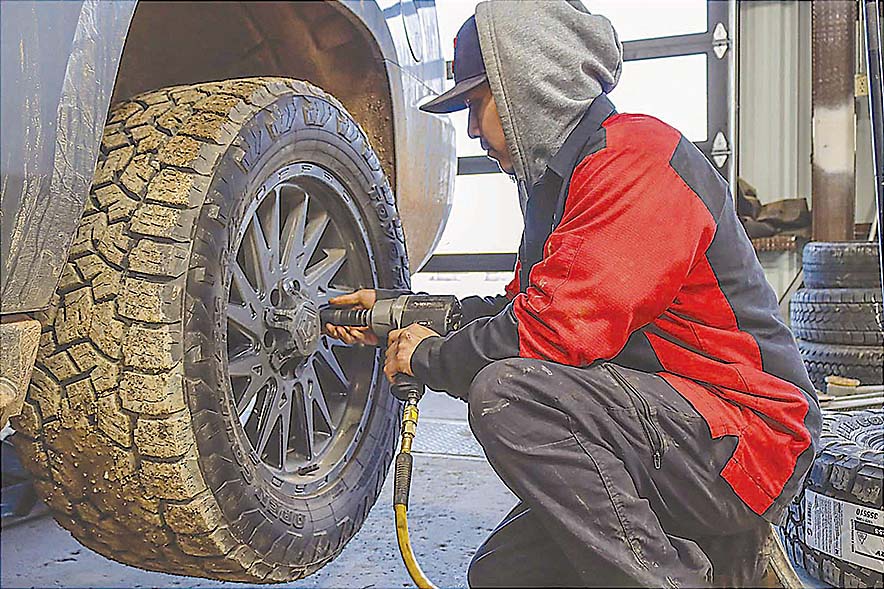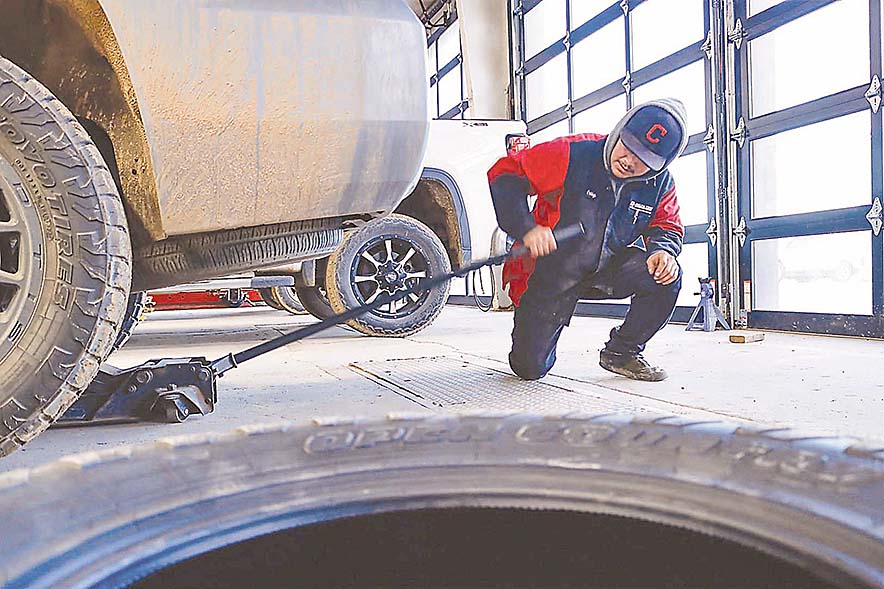
‘Repairs cost a lot’: Tire shops report an increase in pothole damage repairs

Navajo Times | Boderra Joe
Tire technician Colby Livingston at Delta Tire in Gallup prepares to unscrew bolts from a wheel on Monday. Livingston said he sees tire and wheel damage daily as a tire tech with more than a year of experience.
GANADO, Ariz. – Many drivers are hitting potholes on roads and highways in Fort Defiance Agency, damaging their vehicle’s tires, which ultimately leaves tire shops bare witnesses to these types of damage.
According to motorists, one pothole on Route 15, between Lower Greasewood and Ganado, is causing tire blowouts.

Navajo Times | Boderra Joe
Tire technician Colby Livingston at Delta Tire in Gallup places a car jack beneath a vehicle on Monday. Livingston said many people visit the shop because of tire damage from potholes.
Nikyle Begay from Cornfields and Sunrise, Arizona, said the pothole at milepost 93 caused at least five tire blowouts since last week. She said she lives right off the roadway and has collected 10 hubcaps – some damaged. Begay placed the hubcaps nearby in hopes they would be claimed.
“(I) have noticed in the past week, five blown out tires,” Begay wrote in a message. “There (were) about 10 hubcaps. Five of them that weren’t broken, I put on a Fourwing Saltbush next to the road, hoping they’ll be claimed.”
Up toward Teec Nos Pos to Shiprock on U.S. Highway 64, frustrated driver Joshua Lee, who commutes thrice a month, has had his second wheel cracked within six months because of potholes.
Additionally, Lee blew three tires because of cavities in the road. Driving over the holes causes damage not only to vehicles but also to flatbed utility trailers.
“It’s just becoming a bigger issue,” Lee said. He refers to road departments that it has become an issue for daily drivers who encounter potholes.
“The biggest frustration for that is it’s becoming expensive for each individual,” Lee said, as most tire shops vary in cost and stock.
Repairs, rim damages
It is no surprise that many people in the Navajo Nation experience potholes. Joseph Wyatt, a mechanic and tire technician with 10 years of experience at Day’s Custom in St. Michaels, Arizona, sees roughly 10 to 20 vehicles a day for tire repair from pothole damage.
“We get a lot of tire repairs from potholes and rim damages, (which) repairs cost a lot,” Wyatt said. It depends on the size and availability of tires.
Depending on the size of the pothole reflects the amount of damage it does to the tires or rims. Roughly, it costs $10 to $35-plus to repair, according to Wyatt. However, it varies on the size of the tires. As a resident of Sawmill, Arizona, Wyatt has also seen many potholes across the Nation.
The downfall in experiencing a blown tire is relying on the spare. However, Wyatt said most of the newer vehicles do not have a spare, leaving people either purchasing new tires and rims or being left stranded.
How potholes form
Navajo Nation Division of Transportation’s administrative services officer Sheila Clyde said potholes are formed from subgrade, with the bottom layer weakening because of heavy traffic.
“These roads were built with a small average daily challenge,” said Clyde, who has been with Navajo DOT for 12 years. “We didn’t expect truckers to come through every day, all day.”
According to Navajo DOT GIS (geographic information systems) Supervisor Jonah Begay, water is the leading cause of damaging roadways. Even though rain is needed to alleviate drought, water is the prime cause of damage in the subgrade, meaning the native material underneath a constructed road.
“Subgrades can get compromised,” Begay said. “Once water starts going into the cracks on highways, it will start to (compromise) underneath.”
Once this happens, most heavy trucks and buses break down the pavement to deteriorate. A small pothole would form, and with continuous vehicles passing, it almost stresses the pavement and weakens it.
“It’s how these potholes grow,” said Begay, who has been with Navajo DOT for 12 years. “The more water that goes in, the more underneath gets compromised.”
While smooth paved roads are essential and expected throughout the Navajo Nation, Clyde said one asks who is responsible for these roads.
As far as the roads department, Clyde and the team take care of dirt roads and not so much main highways as those are in the hands of the Arizona Department of Transportation, the New Mexico Department of Transportation, and the Bureau of Indian Affairs. The BIA didn’t respond to the Navajo Times’ request for comment by Tuesday afternoon’s deadline.
“We (Navajo DOT) don’t really take care of the main highways,” Clyde said. “We assist if needed.”
But arterial roads must be maintained, especially state and BIA roads.
“Speaking of potholes, I was just talking to my guys,” Clyde said of the daily high traffic between Burnside and Cornfields. “We’re getting a lot of complaints on (Route) 15.
“I’m getting a lot of calls on that today (Jan. 29), and we probably have to help BIA with that job,” he said.
Begay said most BIA roads were built 30 to 40 years ago. Regular wear and tear are deteriorating the pavements.
Similarly, how potholes are formed is how sinkholes are formed: the deterioration over time beneath the subgrade.
“The main thing is drainage,” Clyde said. Snow melts and runs down the mountains, and it’s unknown where the water will go.
“Any pavement that you see, once it’s compromised, they start forming potholes,” Begay said.
As far as icy roads, Clyde said snowplows do not drop their blade and go free for all but more scrape the top layer because of the weight of the truck itself. Most areas use deicing chemicals to melt the ice quickly. Clyde
said precautions are taken as chemicals may decay the pavement over time.
Local tire shops echo potholes are an issue
John Droll, a cashier at Rainbow Tire in Gallup, said people hit potholes and bring their vehicles to “receive treatment.” Droll, who has 10 years of tire technician experience, said when one hits a pothole, air is knocked out of the tire or tears the tire and cracks the rim.
“Some of the newer models, even some of the older, would have a hard time finding a rim for (the vehicle),” Droll said. Rainbow Tire’s tire repair is roughly $10 to $15, but it depends on the damage to the tire and what needs to be replaced.
Andres Romero, the operational manager at Delta Tire in Gallup, said the business sees a lot of pothole damage when customers arrive at the shop.
“We do warranty a lot of tires because they are covered under a road hazard warranty,” Romero said.
Romero said his crew sees roughly three to six tire damages daily because of potholes. One of his tire technicians, Colby Livingston, said he changed a lot of tires and fixed wheel damages from potholes.
Although Delta Tire is in Gallup and has heavy traffic from Interstate 40, it attracts more customers with tire damage because of potholes on the freeway.
Jonah Begay at Navajo DOT said potholes form quicker on high-traffic roads, such as main highways and freeways, where semis and large vehicles travel.
Romero said when he sees a vehicle’s struts broken because of a driver hitting a pothole, that’s called “impactable damage.” If one pays out of pocket to repair damage, Delta Tire provides customers a Tort Claim form to file a claim within 90 days after an incident, such as damage from a pothole.
“You can put in that claim if New Mexico finds that true, the state will pay for that claim,” Romero said.
According to Clyde, the Tort Claim also applies in Arizona, and it is what Navajo DOT recommends as a first step, depending on what state one is in.
Published Feb. 1, 2024 Updated Feb. 3, 2024
A correction was made on February 3, 2024: An earlier version of this article misspelled the name of the cashier at Rainbow Tire in Gallup. It’s John Droll, not John Drool.








 Highway 264,
Highway 264, I-40, WB @ Winslow
I-40, WB @ Winslow